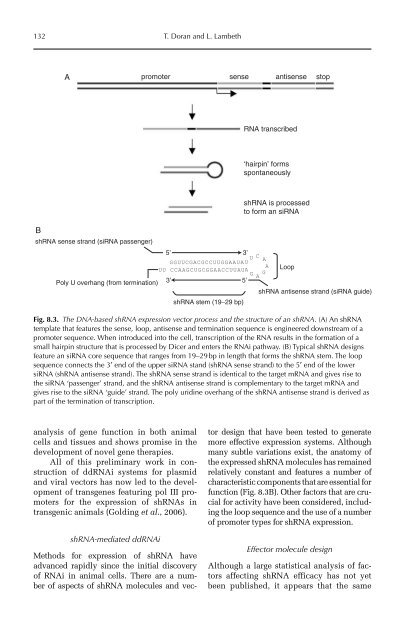Redesigning Animal Agriculture
Redesigning Animal Agriculture
Redesigning Animal Agriculture
Create successful ePaper yourself
Turn your PDF publications into a flip-book with our unique Google optimized e-Paper software.
132 T. Doran and L. Lambeth<br />
B<br />
A<br />
shRNA sense strand (siRNA passenger)<br />
Fig. 8.3. The DNA-based shRNA expression vector process and the structure of an shRNA. (A) An shRNA<br />
template that features the sense, loop, antisense and termination sequence is engineered downstream of a<br />
promoter sequence. When introduced into the cell, transcription of the RNA results in the formation of a<br />
small hairpin structure that is processed by Dicer and enters the RNAi pathway. (B) Typical shRNA designs<br />
feature an siRNA core sequence that ranges from 19–29 bp in length that forms the shRNA stem. The loop<br />
sequence connects the 3′ end of the upper siRNA stand (shRNA sense strand) to the 5′ end of the lower<br />
siRNA (shRNA antisense strand). The shRNA sense strand is identical to the target mRNA and gives rise to<br />
the siRNA ‘passenger’ strand, and the shRNA antisense strand is complementary to the target mRNA and<br />
gives rise to the siRNA ‘guide’ strand. The poly uridine overhang of the shRNA antisense strand is derived as<br />
part of the termination of transcription.<br />
analysis of gene function in both animal<br />
cells and tissues and shows promise in the<br />
development of novel gene therapies.<br />
All of this preliminary work in construction<br />
of ddRNAi systems for plasmid<br />
and viral vectors has now led to the development<br />
of transgenes featuring pol III promoters<br />
for the expression of shRNAs in<br />
transgenic animals (Golding et al., 2006).<br />
shRNA-mediated ddRNAi<br />
Methods for expression of shRNA have<br />
advanced rapidly since the initial discovery<br />
of RNAi in animal cells. There are a number<br />
of aspects of shRNA molecules and vec-<br />
promoter sense antisense stop<br />
RNA transcribed<br />
‘hairpin’ forms<br />
spontaneously<br />
shRNA is processed<br />
to form an siRNA<br />
5’<br />
3’<br />
U C<br />
A<br />
GGUUCGACGCCUUGGAAUAU<br />
A<br />
UU CCAAGCUGCGGAACCUUAUA<br />
Loop<br />
G G<br />
A<br />
Poly U overhang (from termination) 3’<br />
5’<br />
shRNA antisense strand (siRNA guide)<br />
shRNA stem (19−29 bp)<br />
tor design that have been tested to generate<br />
more effective expression systems. Although<br />
many subtle variations exist, the anatomy of<br />
the expressed shRNA molecules has remained<br />
relatively constant and features a number of<br />
characteristic components that are essential for<br />
function (Fig. 8.3B). Other factors that are crucial<br />
for activity have been considered, including<br />
the loop sequence and the use of a number<br />
of promoter types for shRNA expression.<br />
Effector molecule design<br />
Although a large statistical analysis of factors<br />
affecting shRNA efficacy has not yet<br />
been published, it appears that the same










